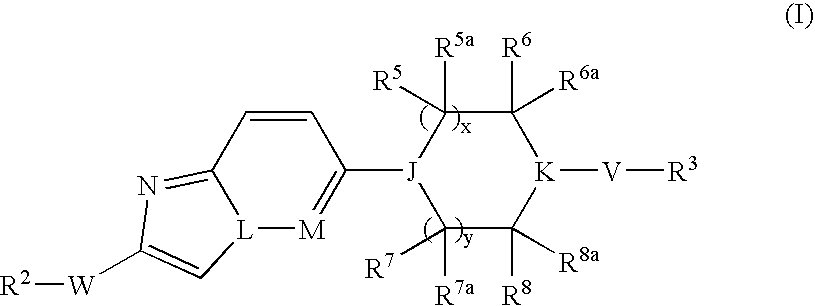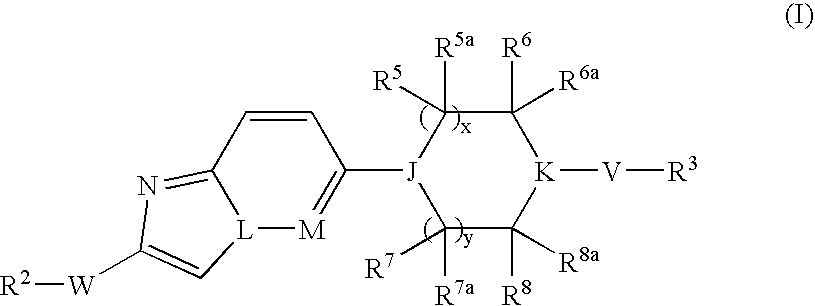Bicyclic Heterocyclic Derivatives and Their Use as Inhibitors of Stearoyl-Coadesaturase (Scd)
a technology of stearoylcoa desaturase and bicyclic heterocyclic derivatives, which is applied in the direction of heterocyclic compound active ingredients, chemical treatment enzyme inactivation, biocide, etc., can solve the problems that known modulators of delta-9 desaturase activity are not useful for treating diseases and disorders linked to scd1 biological activity, and achieve effective modulation of triglyceride level, reduce lipid level, and improve lipid level
- Summary
- Abstract
- Description
- Claims
- Application Information
AI Technical Summary
Benefits of technology
Problems solved by technology
Method used
Image
Examples
preparation 1
SYNTHESIS OF 6-PIPERAZIN-1-YLIMIDAZO[1,2-B]PYRIDAZINE-2-CARBOXYLIC ACID ETHYL ESTER
[0249] A mixture of 6-chloroimidazo[1,2-b]pyridazine-2-carboxylic acid ethyl ester (1.000 g, 4.432 mmol), piperizine (0.458 g, 5.318 mmol) and potassium carbonate (0.620 g, 4.485 mmol) in 50 mL of toluene was refluxed for 48 hours. The reaction mixture was concentrated in vacuo, diluted with water and extracted with ethyl acetate. The crude product, 6-piperazin-1-ylimidazo[1,2-b]pyridazine-2-carboxylic acid ethyl ester, obtained upon removal of solvent was used for next step reaction without further purification. Yield 1.016 g, 83%.
preparation 2
SYNTHESIS OF 6-[4-(5-FLUORO-2-TRIFLUOROMETHYLBENZOYL)PIPERAZIN-1-YL]IMIDAZO[1,2-B]PYRIDAZINE-2-CARBOXYLIC ACID ETHYL ESTER
[0250] To a solution of 6-piperazin-1-ylimidazo[1,2-b]pyridazine-2-carboxylic acid ethyl ester (1.016 g, 3.69 mmol) and diisopropylethylamine (1.29 mL, 7.38 mmol) in anhydrous dichloromethane (20 mL) was added 5-fluoro-2-trifluoromethylbenzoyl chloride dropwise at room temperature. The reaction mixture was stirred at room temperature for 15 minutes, then diluted with dichloromethane and washed with water. The organic layer was dried and concentrated in vacuo. The title compound was obtained in 82% yield (1.365 g) after purification by column chromatography.
preparation 3
SYNTHESIS OF 3-CYCLOPROPYLPROPYLAMINE
[0251] p-Toluenesulfonyl chloride (7.20 g, 37.8 mmol) was added to a cooled (0° C.) solution of 2-cyclopropylethanol (4.00 g, 46.4 mmol) in pyridine (10 mL) and dichloromethane (60 mL). The reaction mixture was stirred at room temperature overnight, then diluted with ether (200 mL) and washed sequentially with water, 10% HCl, water and brine and then dried over anhydrous Na2SO4. Toluene-4-sulfonic acid 2-cyclopropylethyl ester (8.1 g, 89%) was obtained after removal of solvent and used for next step reaction without further purification.
[0252] A mixture of toluene-4-sulfonic acid 2-cyclopropylethyl ester (8.1 g, 33.7 mmol), sodium cyanide (5.0 g, 102 mmol) and tetrabutylammonium iodide (0.5 g) in DMF (30 mL) was heated at 90° C. overnight. The reaction mixture was then cooled to room temperature, diluted with ether (200 mL), washed with water and brine, and dried over anhydrous Na2SO4. 3-Cyclopropylpropionitrile (3.2 g, 99%) was obtained after ...
PUM
| Property | Measurement | Unit |
|---|---|---|
| temperature | aaaaa | aaaaa |
| particle size | aaaaa | aaaaa |
| flow rate | aaaaa | aaaaa |
Abstract
Description
Claims
Application Information
 Login to View More
Login to View More - R&D
- Intellectual Property
- Life Sciences
- Materials
- Tech Scout
- Unparalleled Data Quality
- Higher Quality Content
- 60% Fewer Hallucinations
Browse by: Latest US Patents, China's latest patents, Technical Efficacy Thesaurus, Application Domain, Technology Topic, Popular Technical Reports.
© 2025 PatSnap. All rights reserved.Legal|Privacy policy|Modern Slavery Act Transparency Statement|Sitemap|About US| Contact US: help@patsnap.com



